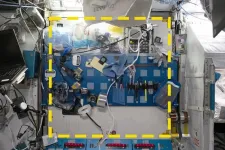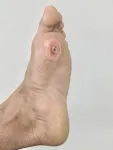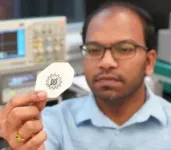(Press-News.org) An archaeological strategy adapted for space used daily photos to reveal how astronauts actually use areas aboard the International Space Station – and how this differs from intended uses. Justin Walsh of Chapman University, California, and colleagues present these findings in the open-access journal PLOS ONE on August 7, 2024.
More than 270 people from 23 countries have visited the International Space Station (ISS) over more than two decades. Crew member interviews can reveal how people adapt to a novel environment—one featuring isolation, confinement, and microgravity—that is far removed from the context in which humans evolved. However, interviews may be unable to capture insights that could be captured by alternative approaches.
In order to better understand the “microsociety” of the ISS, Walsh and colleagues launched the International Space Station Archaeological Project, which applies an archaeological framework to the ISS and studies the materials used by its crew as artifacts.
For their first direct work on the space station, the team adapted a traditional archaeological strategy known as the shovel test pit, in which small pits are dug at intervals across a site to assess artifact distribution and select areas for more extensive excavation. In this case, the archaeologists asked the ISS crew to document six locations around the station, and instead of digging pits, taking daily photos of each location for 60 days in 2022.
The new article reveals findings from the first two of the six sample areas to be fully documented: one designated for equipment maintenance and another near the latrine and exercise equipment. Further analysis of photos in these areas using a novel open-source image analysis platform developed by the team revealed 5,438 instances of “artifacts” being used for varied purposes, such as writing tools, Post-It notes, and an augmented reality headset.
Cross-referencing the photos with astronaut activity reports, the researchers found that the area near the exercise equipment and latrine, while not designated for any particular purpose, had been used as storage for toiletries, resealable bags, and a rarely used computer. The equipment maintenance area was used primarily for storage, with little or no maintenance actually carried out there.
These findings demonstrate how traditional archaeological techniques can be adapted to study remote or extreme habitats. The findings could also help inform development of future space habitats.
The authors add: “The experiment is the first archaeology ever to happen off of the planet Earth. By applying a very traditional method for sampling a site to a completely new kind of archaeological context, we show how the ISS crew uses different areas of the space station in ways that diverge from designs and mission plans. Architects and planners of future space stations can learn valuable lessons from this work.”
#####
In your coverage please use this URL to provide access to the freely available article in PLOS ONE: https://journals.plos.org/plosone/article?id=10.1371/journal.pone.0304229
Citation: Walsh JSP, Graham S, Gorman AC, Brousseau C, Abdullah S (2024) Archaeology in space: The Sampling Quadrangle Assemblages Research Experiment (SQuARE) on the International Space Station. Report 1: Squares 03 and 05. PLoS ONE 19(8): e0304229. https://doi.org/10.1371/journal.pone.0304229
Author Countries: USA, Australia
Funding: JW was the recipient of funding from Chapman University’s Office of Research and Sponsored Programs to support the activities of Axiom Space as implementation partner for the research presented in this article. There are no associated grant numbers for this financial support. Axiom Space served in the role of a contractor hired by Chapman University for the purpose of overseeing logistics relating to our research. In-kind support in the form of ISS crew time and access to the space station’s facilities, also awarded to JW from the ISS National Laboratory, resulted from an unsolicited proposal, and therefore there is no opportunity title or number associated with our work. No salary was received by any of the investigators as a result of the grant support. No additional external funding was received for this study.
END
International Space Station crew carries out first-ever archeological survey in space
Study finds discrepancies between intended and actual use of certain areas aboard the space station
2024-08-07
ELSE PRESS RELEASES FROM THIS DATE:
Electric bandage holds promise for treating chronic wounds
2024-08-07
Researchers have developed an inexpensive bandage that uses an electric field to promote healing in chronic wounds. In animal testing, wounds that were treated with these electric bandages healed 30% faster than wounds treated with conventional bandages.
Chronic wounds are open wounds that heal slowly, if they heal at all. For example, sores that occur in some patients with diabetes are chronic wounds. These wounds are particularly problematic because they often recur after treatment and significantly increase the risk of amputation and death.
One of the challenges associated ...
Researchers unlock life history secrets of Jurassic mammals using X-ray imaging
2024-08-07
A new study published in Science Advances reveals how early mammals grew and developed during their pivotal Jurassic radiation. Using a technique called synchrotron X-ray tomography to image growth rings in fossilised tooth roots, the researchers were able to estimate lifespans, growth rates, and even the timing of sexual maturity in these ancient creatures.
“This is the first time we've been able to reconstruct the growth patterns of these early mammals in such detail,” said Dr Elis Newham, a Postdoctoral Research Associate ...
Studying how serotonin alters locust’s sense of smell
2024-08-07
By Leah Shaffer
Researchers at Wash U have spent the better part of the decade studying the ins and outs of how locusts smell, including how odors affect the insect’s behavior.
In research recently published in eLife, Barani Raman, a professor of biomedical engineering at the McKelvey School of Engineering, starts to map out just how olfactory circuits are altered in driving different behavior in locusts. Neuromodulator serotonin is a key factor in triggering how locusts can go from being a “loner” to “gregarious” — otherwise known as swarming ...
Physician-scientist named Academy of Immuno-Oncology fellow
2024-08-07
Immunotherapy pioneer Dr. Antoni Ribas, professor of medicine at the David Geffen School of Medicine at UCLA and director of the tumor immunology program at the UCLA Health Jonsson Comprehensive Cancer Center, has been inducted into the 2024 Class of Fellows of the Academy of Immuno-Oncology by the Society for Immunotherapy of Cancer.
The recognition is one of the highest honors bestowed by the society and is given to scientists who have made seminal contributions in the field of cancer immunotherapy.
Ribas, an internationally renowned physician-scientist, has dedicated his career to improving the lives of people with cancer worldwide. His discoveries have led to the development of ...
How media impacts digital technology adoption in U.S. and Brazilian agriculture
2024-08-07
URBANA, Ill. -- Digital technologies on the farm improve efficiency, productivity, and profits, but few farmers are taking full advantage of available tools. According to University of Illinois Urbana-Champaign researchers, communication channels play an important role in farmers’ decision-making process around technology adoption. A new study in the journal Agriculture looks at how traditional media, social media, and interpersonal meetings influence soybean farmers in the U.S. and Brazil, both world leaders in soybean production.
“Like everyone ...
New Center of Excellence at Chapman University will study quantum theory and the nature of reality
2024-08-07
An interdisciplinary team of scholars have received a $2.43 million dollar grant from the John Templeton Foundation to create a “Southern California Quantum Foundations Hub” at Chapman University. This unique collaboration includes theoretical physicists, experimental physicists and philosophers, who will apply the methods of their respective disciplines to provide deeper insights into the nature of reality that quantum theory is silent about. The Templeton Foundation has identified the area of quantum foundations ...
Breakthrough study reveals molecular subtypes of Down syndrome, offering insights for personalized medicine approaches
2024-08-07
A new study published in Nature Communications by researchers from the Linda Crnic Institute for Down Syndrome (Crnic Institute) at the University of Colorado Anschutz Medical Campus reports a significant breakthrough. The research, part of the ongoing Crnic Institute Human Trisome Project, identifies distinct molecular and immune subtypes across individuals with Down syndrome, offering new insights that could lead to personalized medicine approaches for the clinical management of this condition.
The Crnic Institute team analyzed the expression of genes encoded on chromosome 21, which is triplicated in those ...
Biophysical Society announces the results of its 2024 Elections
2024-08-07
ROCKVILLE, MD – Karen Fleming has been elected President-elect of the Biophysical Society (BPS). She will assume the office of President-elect at the 2025 Annual Meeting in Los Angeles, California and begin her term as President during the 2026 Annual Meeting in San Francisco, California.
Fleming is a Professor of Biophysics at Johns Hopkins University. She earned a Bachelor of Arts from the University of Notre Dame before going on to achieve a PhD in Biochemistry and Molecular Biology from Georgetown University Medical Center. In addition to her commitment to research, Fleming has dedicated significant time ...
Better understanding cerebral palsy pain types could lead to better treatment
2024-08-07
Pain management is an important component of caring for adults with cerebral palsy.
However, it's the least understood comorbidity in the adult cerebral palsy population.
A study led by Mark Peterson, Ph.D., M.S., FACSM, a professor of physical medicine and rehabilitation at University of Michigan Health, found that adults living with cerebral palsy had a very high occurrence of pain, with 90% having a pain history and 74% having multiple diagnoses of pain coming from different origins such as the lower back, irritable bowels, joint arthritis and chronic ...
How ribosomes in our cells enable protein folding
2024-08-07
Scientists at UCL have discovered a novel role played by ribosomes during the folding of new proteins in cells, described in their paper in Nature.
Ribosomes, the cell’s dedicated molecular machines for protein synthesis, make all proteins in life and do so by piecing together one amino acid building block at a time. As they are being synthesised, these nascent proteins simultaneously attempt to fold while still associated to their parent ribosome, referred to as co-translational protein folding.
Understanding how exactly ...
LAST 30 PRESS RELEASES:
Korea University researchers discover that cholesterol-lowering drug can overcome chemotherapy resistance in triple-negative breast cancer
Ushikuvirus: A newly discovered giant virus may offer clues to the origin of life
Boosting the cell’s own cleanup
Movement matters: Light activity led to better survival in diabetes, heart, kidney disease
Method developed to identify best treatment combinations for glioblastoma based on unique cellular targets
Self-guided behavioral app helps children with epilepsy sleep earlier
Higher consumption of food preservatives is associated with an increased risk of type 2 diabetes
NTU Singapore-led team captures first-ever ‘twitch’ of the eye’s night-vision cells as they detect light, paving the way for earlier detection of blindness-causing diseases
Global aviation emissions could be halved through maximising efficiency gains, new study shows
Fewer layovers, better-connected airports, more firm growth
Exposure to natural light improves metabolic health
As we age, immune cells protect the spinal cord
New expert guidance urges caution before surgery for patients with treatment-resistant constipation
Solar hydrogen can now be produced efficiently without the scarce metal platinum
Sleeping in on weekends may help boost teens’ mental health
Study: Teens use cellphones for an hour a day at school
After more than two years of war, Palestinian children are hungry, denied education and “like the living dead”
The untold story of life with Prader-Willi syndrome - according to the siblings who live it
How the parasite that ‘gave up sex’ found more hosts – and why its victory won’t last
When is it time to jump? The boiling frog problem of AI use in physics education
Twitter data reveals partisan divide in understanding why pollen season's getting worse
AI is quick but risky for updating old software
Revolutionizing biosecurity: new multi-omics framework to transform invasive species management
From ancient herb to modern medicine: new review unveils the multi-targeted healing potential of Borago officinalis
Building a global scientific community: Biological Diversity Journal announces dual recruitment of Editorial Board and Youth Editorial Board members
Microbes that break down antibiotics help protect ecosystems under drug pollution
Smart biochar that remembers pollutants offers a new way to clean water and recycle biomass
Rice genes matter more than domestication in shaping plant microbiomes
Ticking time bomb: Some farmers report as many as 70 tick encounters over a 6-month period
Turning garden and crop waste into plastics
[Press-News.org] International Space Station crew carries out first-ever archeological survey in spaceStudy finds discrepancies between intended and actual use of certain areas aboard the space station



